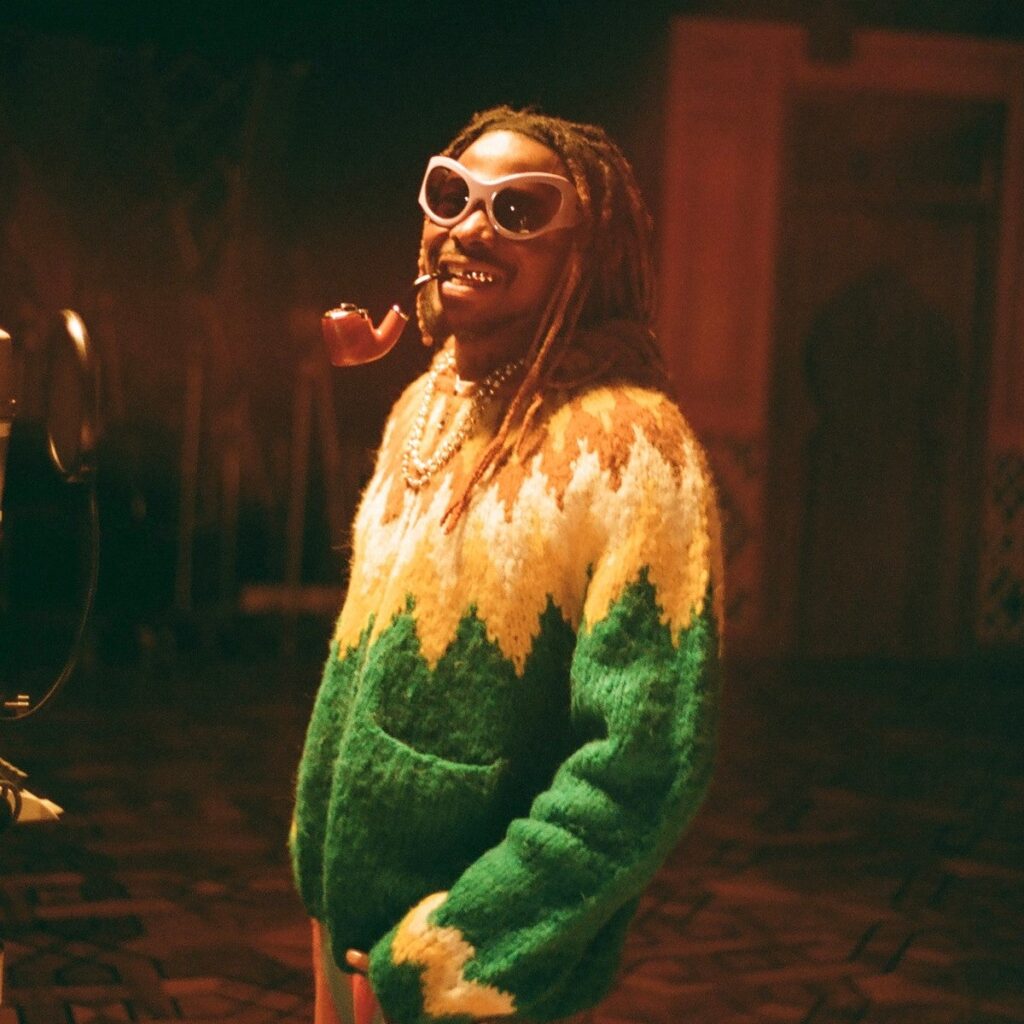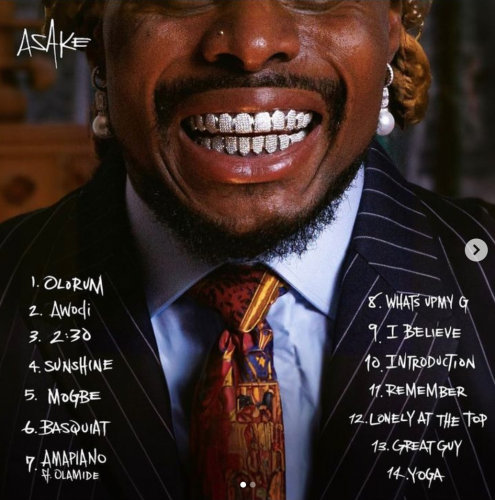Work of Art demonstrates that even the biggest and most accomplished artistes are still Works in Progress, and while his stock will not suffer as a singles artiste or a hit maker, I think the shortcomings of this album do enough to raise an eyebrow at his pedigree as an album artiste…
By Yinoluwa Olowofoyeku
Ahmed Ololade, professionally known as Asake (a name he adopted from his mother), is a Nigerian Afropop singer-songwriter. Born and bred in Lagos, Nigeria, Ololade took something of a detour into the music industry after a developing career as a dancer. He studied dramatic arts at the Obafemi Awolowo University, a course which laid the foundation for his expertise as a performer. Music became his medium of expression in 2018.
His career as we know it began in 2020 when his “Lady” freestyle went viral, pricking the ears of big wigs in the industry. In that same year, he released the hit song, “Mr. Money,” and stamped his emergence on the scene by winning two of the three City People Music Awards he was nominated for. 2022 was the year that vaulted his trajectory into the stratosphere. Following his signing to Olamide’s YBNL Records imprint, he would release his debut EP, Ololade, that was propelled to the mainstream on the back of “Sungba” and its eventual Burna Boy-assisted remix.
His debut studio album, Mr. Money with the Vibe, would steal the world’s attention towards the end of the year, boasting hits such “Terminator,” “Peace Be Unto You” and “Organise.” A tour quickly followed, and bar some unfortunate events at a show in Brixton, London, it was evident that Asake was cementing his place in the industry and in the minds of fans. And while his impact continues to reverberate through the music landscape till date, Asake decided to strike while the iron was hot, releasing Work of Art to the public.
(Read also: Bloody Civilian Creatively Expresses Her Rage on Anger Management EP)
The album gets off to a really great start with “Olorun,” a sweet atmospheric opener. Somber keys are bolstered by weepy strings and haunting choral voices. Asake glides in smoothly with a humble and reverent delivery. The song effectively details surrender to God and His plans as soft saxophones and sharp guitars fill the space with fleeting accents. A soft-spoken log drum pattern enters the fray as the song winds down, setting the tone for a meditative innovative journey through Asake’s personal experiences.
The strong opening continues on “Awodi,” an upbeat offering with surprisingly introspective and thoughtful lyrics. These thoughts are presented with strong melodic singing and fast-flowing wordplay atop a very light instrumental defined by extremely soft electric pianos, sparse percussions, and tempered log drums. I feel the sax solos ran too long through the song and more moderation could have been welcome here.
“2:30” seals the impressive opening, starting with rattling shakers and spacious percussion over a gentle synth chord progression. Effects-heavy log drums pound away to give the song an almost futuristic feel, grounded by the droning strings. Asake rides the highly rhythmic beat with ridiculously dexterous delivery, switching up his timing, tone, and intensity as the beat demands it of him.

“Sunshine” is an uplifting motivational track, preaching the rewards of hard work and efficient hustling. It has a strong melodic core, building on a common basic chord progression with signature group vocals and instrumental solos in the background.
“Mogbe” is a playful confession of love and an acceptance of all the things that could come with it. The rattling shakers and evenly distributed drums are propped up by a lively log-drum bassline and energy-infusing synthetic whistles. Asake’s expert use of group vocals is a significant strength on this song as he picks the right moments for harmonies, call-and-response, or simply ad-libs, all the voices intermarrying to create a very compelling tune.
“Basquiat” brings back the Asake formula instrumentally, featuring subtle Amapiano synths, barely perceptible keys, and soloing instruments in the background. This song displays Asake at his best; his vocals are clear enough to follow, and his delivery is uncannily flexible, seeing him switch from long sung passes to the quickfire rhyming sections he is becoming known for.
“Amapiano” ushers out a completely different side of Asake, as he practically raps with a new bravado and poise on the admittedly bouncy instrumentals. Olamide brings a fresh voice and sonic perspective to this beat that also seems to be very much out of the “Asake-Beats” wheelhouse, making me wonder if Asake could have done with a few more featured artists to provide their own spin on the environment.
(Read also: Amaarae Flexes Her Range on Fountain Baby LP)
As we turn into the second half of the album with “What’s Up My G,” the album takes a turn for the worse. Not because the songs get any worse, but because this is the point where you realise that you’ve heard practically everything Asake has to offer on this album. The sparse unchanging snares, wildly effected log drums, understated keys, sax and string solos, minimal synths, and group vocals backing up his singular vocal track, begin to all blend into each other, making the songs difficult to pick out of a crowd on the merit of just their musical elements. There still are a few idiosyncrasies to be found in each song, such as the more prominent snare hit in “I Believe,” the full keys on “Remember,” the distinctly Afrobeats vibe generated by the live bass and signature Afropop drums pattern on “Lonely at the Top” and the admittedly distracting use of flaming log drums, in “Great Guy.”
While Asake always makes good with his Yoruba-heavy lyrics and Fuji-like story-telling, the last run of songs emphasised how limited the palette of the album was. Even his stellar deliveries and melodic sense could not brighten up this grey cloud as those also became culprits of the monotony that was creeping in. From languid hooks and overfamiliar melodies to an over-reliance on that cadence where he rhymes a lot of words in quick succession, the songs towards the tail end of Work of Art make me wonder whether Asake has painted himself into a stylistic corner.
Thankfully, “Yoga” serves to end the album on a meditative Folk-adjacent exploration that breaks up the sonic homogeneity that was developing. The song speaks on protecting our peace and maintaining our lanes as traditional percussions rattle away accompanied by that same backing sax from before.
(Read also: Guchi Displays Full Romantic Side in New Two-Pack Single)

Work of Art is a project that was supposed to hoist Asake to even higher heights propped up by this Fuji-fused Amapiano sound that he developed and popularised. However, I think the album turns around and, instead, shines a light on what may be weaknesses we didn’t notice in the honeymoon phase of listening to Asake. His song-writing is still as sharp as ever as he pulls references, slang, proverbs and adages together to craft fun and detailed narratives to get the listener through the song. Ideally, Asake conveys these words with deceptively strong singing skills. He can hold a note with the best of them and he has proven himself melodically and rhythmically agile many times. Yet for some reason, as this project drags on, those melodies begin to be re-used, cadences are recycled, and the same tricks are relied on a few times too many. The strength of Olamide’s feature makes me wonder why Asake did not have more featured artists on this album. Not only would the artistes bring diverse vocal textures and patterns to the songs, they would also inject new personality in the stories.
The technical engineering of the album is top-notch as expected, but the production leaves a lot to be desired. Full Amapiano albums with instrumental diversity, tonal variation, and innovative direction are put out frequently enough for it to have been within Asake’s reach. Majority of the production on Work of Art sounds like Magicsticks was simply reusing instruments between projects. About 4 or 5 songs have the exact same snare drum used, or the same sax and string backing instrumentation, or the same effects and rolls on the same log drums. The album suffers for it. The sonics could have been cohesive without needing to become wearisome. The sad thing is that, many of the songs on Work of Art are good enough songs on their own individual standing but as a congruent project to be enjoyed front-to-back, it’s a little too much of the same thing. The tracks cannibalise the effectiveness of each other.

At the end of the day, Work of Art demonstrates that even the biggest and most accomplished artistes are still Works in Progress, and while his stock will not suffer as a singles artiste or a hit maker, I think the shortcomings of this album do enough to raise an eyebrow at his pedigree as an album artiste. Let’s hope he takes some time off to assemble the next album, and that it can silence growing concerns.
Lyricism – 1.5
Tracklisting – 1.2
Sound Engineering – 1.4
Vocalisation – 1.7
Listening Experience – 1.1
Rating – 6.9/10
Yinoluwa “Yinoluu” Olowofoyeku is a multi-disciplinary artist and creative who finds expression in various media.



